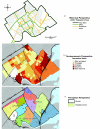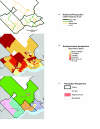A multi-perspective approach for defining neighbourhood units in the context of a study on health inequalities in the Quebec City region
- PMID: 17615065
- PMCID: PMC1936419
- DOI: 10.1186/1476-072X-6-27
A multi-perspective approach for defining neighbourhood units in the context of a study on health inequalities in the Quebec City region
Abstract
Background: Identification of socioeconomic and health inequalities at the local scale is facilitated by using relevant small geographical sectors. Although these places are routinely defined according to administrative boundaries on the basis of statistical criteria, it is important to carefully consider the way they are circumscribed as they can create spatial analysis problems and produce misleading information. This article introduces a new approach to defining neighbourhood units which is based on the integration of elements stemming from the socioeconomic situation of the area, its history, and how it is perceived by local key actors.
Results: Using this set of geographical units shows important socioeconomic and health disparities at the local scale. These disparities can be seen, for example, in a 16-year difference in disability-free life expectancy at birth, and a $10,000-difference in average personal income between close neighbourhoods. The geographical units also facilitate information transfer to local stakeholders.
Conclusion: The context of this study has made it possible to explore several relevant methodological issues related to the definition of neighbourhood units. This multi-perspective approach allows the combination of many different elements such as physical structures, historical and administrative boundaries, material and social deprivation of the population, and sense of belonging. Results made sense to local stakeholders and helped them to raise important issues to improve future developments.
Figures




Similar articles
-
Exploring rural health inequalities at a local scale: the case of Portneuf, Québec.Can J Public Health. 2007 Mar-Apr;98(2):143-8. doi: 10.1007/BF03404327. Can J Public Health. 2007. PMID: 17441540 Free PMC article.
-
Double burden of deprivation and high concentrations of ambient air pollution at the neighbourhood scale in Montreal, Canada.Soc Sci Med. 2009 Sep;69(6):971-81. doi: 10.1016/j.socscimed.2009.07.010. Epub 2009 Aug 5. Soc Sci Med. 2009. PMID: 19656603
-
Perception of place and health: differences between neighbourhoods in the Québec City region.Soc Sci Med. 2007 Jul;65(1):95-111. doi: 10.1016/j.socscimed.2007.02.044. Epub 2007 Apr 5. Soc Sci Med. 2007. PMID: 17418468
-
A brief conceptual tutorial on multilevel analysis in social epidemiology: interpreting neighbourhood differences and the effect of neighbourhood characteristics on individual health.J Epidemiol Community Health. 2005 Dec;59(12):1022-8. doi: 10.1136/jech.2004.028035. J Epidemiol Community Health. 2005. PMID: 16286487 Free PMC article. Review.
-
Toward the next generation of research into small area effects on health: a synthesis of multilevel investigations published since July 1998.J Epidemiol Community Health. 2007 Oct;61(10):853-61. doi: 10.1136/jech.2006.050740. J Epidemiol Community Health. 2007. PMID: 17873220 Free PMC article. Review.
Cited by
-
Health status convergence at the local level: empirical evidence from Austria.Int J Equity Health. 2011 Aug 24;10:34. doi: 10.1186/1475-9276-10-34. Int J Equity Health. 2011. PMID: 21864364 Free PMC article.
-
Local context influence, activity space, and foodscape exposure in two canadian metropolitan settings: is daily mobility exposure associated with overweight?J Obes. 2012;2012:912645. doi: 10.1155/2012/912645. Epub 2011 Dec 28. J Obes. 2012. PMID: 22254135 Free PMC article.
-
Living environments and health at the local level: the case of three localities in the Québec city region.Can J Public Health. 2007 Jul-Aug;98 Suppl 1(Suppl 1):S45-53. doi: 10.1007/BF03403726. Can J Public Health. 2007. PMID: 18047160 Free PMC article.
-
Defining socially-based spatial boundaries in the region of Peel, Ontario, Canada.Int J Health Geogr. 2011 May 21;10:38. doi: 10.1186/1476-072X-10-38. Int J Health Geogr. 2011. PMID: 21600012 Free PMC article.
-
Catchments of general practice in different countries--a literature review.Int J Health Geogr. 2014 Aug 29;13:32. doi: 10.1186/1476-072X-13-32. Int J Health Geogr. 2014. PMID: 25174719 Free PMC article. Review.
References
-
- Block JP, Scribner RA, DeSalvo KB. Fast food, race/ethnicity, and income: a geographic analysis. American journal of preventive medicine. 2004;27:211–217. - PubMed
Publication types
MeSH terms
LinkOut - more resources
Full Text Sources
Other Literature Sources
Medical

